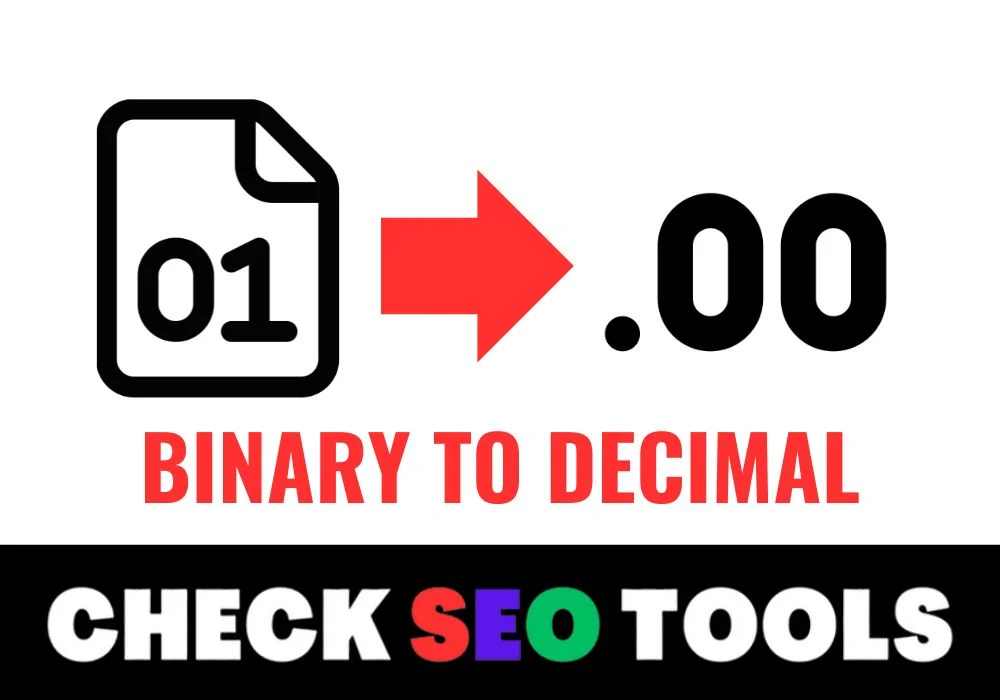Binary To Decimal Converter
It is really very easy to use the tool Binary To Decimal Converter. It helps you to convert Binary To Decimal. To use the tool, enter the text or upload and click on 'Convert to Decimal' button.
Share on Social Media:
Understanding the Binary to Decimal Converter Tool and Its Everyday Applications
In the world of computing and digital communication, different numeral systems are used to represent and process information. One crucial conversion is from binary to decimal. Our Binary to Decimal Converter tool simplifies this process, making it quick and efficient. This article will explain what a Binary to Decimal Converter is, provide related definitions, and explore its usefulness in daily life with practical examples.

What is a Binary to Decimal Converter?
A Binary to Decimal Converter is an online tool that translates binary numbers (base-2) into decimal numbers (base-10). Binary is the language of computers, consisting only of 0s and 1s, while the decimal system is the standard numeral system used by most people, consisting of digits from 0 to 9.
How Does a Binary to Decimal Converter Work?
The conversion process involves interpreting each binary digit's place value and summing these values to get the decimal equivalent. For example:
- Binary: 1101
- Decimal: 13
Here’s a step-by-step breakdown:
- Write down the binary number and identify the positional values (from right to left, starting at 0):
- 1⋅231 \cdot 2^31⋅23 = 8
- 1⋅221 \cdot 2^21⋅22 = 4
- 0⋅210 \cdot 2^10⋅21 = 0
- 1⋅201 \cdot 2^01⋅20 = 1
- Sum the values:
- 8 + 4 + 0 + 1 = 13
Therefore, the binary number 1101 converts to the decimal number 13.
Related Definitions
To better understand the Binary to Decimal Converter, here are some key definitions:
- Binary System (Base-2): A numerical system that uses only two digits, 0 and 1. It is the fundamental language of computers.
- Decimal System (Base-10): The standard numeral system used in everyday life, consisting of digits from 0 to 9.
- Numeral Systems: Different ways to represent numbers. The most common ones include binary, decimal, octal, and hexadecimal.
Benefits of Using a Binary to Decimal Converter
- Facilitates Programming: Assists programmers in converting binary numbers into decimal format for easier interpretation and manipulation.
- Enhances Learning: Helps students and educators understand binary and decimal systems and their interconversion.
- Efficient Problem-Solving: Simplifies the process of working with binary numbers in various computing tasks.
- Accurate Data Representation: Ensures accurate conversion of binary data to a human-readable decimal format.
How to use our online Binary To Decimal Converter tool?
Step 1. Open your web browser and open checkseotools.com and select online Binary To Decimal Converter tool.
Step 2. On browser, you will see textbox to enter to paste the Binary you want to convert.
Step 3. You can also upload Binary file to convert it to Decimal.
Step 4. Click on Convert to Decimal button.
Practical Uses of a Binary to Decimal Converter
1. Programming and Software Development
Programmers often need to convert binary numbers to decimal to debug, write code, or analyze data.
Example: A software developer debugging a program might use the tool to convert binary error codes into decimal to understand the issue better.
2. Educational Purposes
Teachers and students can use the Binary to Decimal Converter as an educational aid. It provides a practical way to understand numerical systems and their interrelations.
Example: A computer science teacher uses the tool to demonstrate the process of converting binary numbers to decimal, enhancing students' comprehension of data representation.
3. Digital Communication
In digital communication, binary data often needs to be converted to decimal for interpretation and analysis.
Example: A network engineer analyzing binary data packets might use the tool to convert binary addresses into decimal format for easier analysis.
4. Electronics and Hardware Design
Engineers and technicians working with electronic devices and hardware often need to convert binary data into decimal for testing and troubleshooting.
Example: An electronics engineer designing a microcontroller might use the tool to convert binary machine code into decimal values for verification.
Conclusion
Our Binary to Decimal Converter tool is a valuable resource for anyone working with numerical data in computing, education, or digital communication. Its applications range from facilitating programming and enhancing learning to efficient problem-solving and accurate data representation. By converting binary numbers to decimal effortlessly, this tool makes handling and understanding digital data more accessible.
Related Keywords
- Binary to Decimal Converter
- Convert binary to decimal
- Online binary to decimal tool
- Binary to decimal conversion
- Decimal converter
- Numeral systems
- Data conversion tool
- Educational binary converter